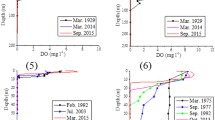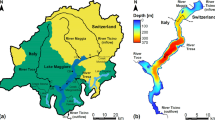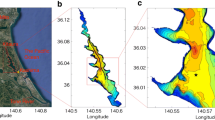Abstract
The effect of the heat interaction between a water column and sediments on the formation, development, and duration of existence of anaerobic zones in ice-covered lakes is estimated based on observational data from five frozen lakes located in northwestern Russia and North America. A simple one-dimensional model that describes the formation and development of the dissolved oxygen deficit in shallow ice-covered lakes is suggested. The model reproduces the main features of dissolved oxygen dynamics during the ice-covered period; that is, the vertical structure, the thickness, and the rate of increase of the anaerobic zone in bottom layers. The model was verified against observational data. The results from the verification show that the model adequately describes the dissolved oxygen dynamics in winter. The consumption rates of DO by bacterial plankton and by bottom sediments, which depend on the heat transfer through the water–sediment interface, are calculated. The results obtained allow the appearance of potentially dangerous anaerobic zones in shallow lakes and in separate lake areas, which result from thermal regime changes, to be predicted.






Similar content being viewed by others
References
Archer D, Devol A (1992) Benthic oxygen fluxes on the Washington shelf and slope: a comparison of in situ microelectrode and chamber flux measurements. Limnol Oceanogr 37:614–629
Boylen C, Brock T (1973) Bacterial decomposition processes in Lake Wingra sediments during winter. Limnol Oceanogr 18(4):628–634
Charlton M (1980) Hypolimnion oxygen consumption in lakes: discussion of productivity and morphometry effects. Can J Fish Aquat Sci 37:1531–1539
Cornett R, Rigler F (1987) Vertical transport of oxygen into the hypolimnion of lakes. Can J Fish Aquat Sci 44:852–858
Golosov S, Zverev I, Terzhevik A (2003) Thermal structure and heat exchange in ice-water column–sediment system. In: Terzhevik A (ed) Proc 7th Int Symp on Physical Processes in Natural Waters, July 2003, Petrozavodsk, Russia, pp 17–28
Golosov S, Shipunova E, Maher OA, Terzhevik A, Zdorovennova G (2005) Physical background of oxygen depletion development in ice-covered lakes. In: Folkard A, Jones I (eds) Proc 9th Europ Workshop on Physical Processes in Natural Waters, 4–6 September 2005, Lancaster University, UK, pp 229–237
Hargrave B (1972) A comparison of sediment oxygen uptake, hypolimnetic oxygen deficit and primary production in Lake Esrom, Denmark. Vehr Int Ver Limnol 18:134–139
Hutchinson G (1957) A treatise on limnology, vol I. Wiley, New York, pp 1015
Jorgensen B, Revsbech N (1985) Diffusive boundary layers and the oxygen uptake of sediments and detritus. Limnol Oceanogr 30:111–122
Kirillin G (2003) Modeling of the shallow lake response to climate variability. In: Terzhevik A (ed) Proc 7th Int Symp on Physical Processes in Natural Waters, July 2003, Petrozavodsk, Russia, pp 144–148
Kovaleva N, Medientz V, Gazetov E (2003) Influence of temperature and oxygen content on the intensity of the organic matter decay in Black Sea (in Russian). Gidrobiologicheskiy Z (J Hydrobiol) 39(4):34–40
Lorke A, Muller B, Maerki M, Wuest A (2003) Breathing sediments: the control of diffusive transport across the sediment–water interface by periodic boundary-layer turbulence. Limnol Oceanogr 48(6):2077–2085
Mathias J, Barica J (1980) Factors controlling oxygen depletion in ice-covered lakes. Can J Fish Aquat Sci 37:185–194
Meding M (2000) Structure and function in shallow prairie lakes: macrophytes and winter anoxia. Thesis, University of Calgary, Canada, p 124
Mironov D, Golosov S, Zilitinkevich S, Kreiman K, Terzhevik A (1991) Seasonal changes of temperature and mixing conditions in a lake. In: Zilitinkevich S (ed) Modelling air–lake interaction. Physical background. Springer, Berlin Heidelberg New York, pp 74–90
Welch H, Dillon P, Sreedharan A (1976) Factors affecting winter respiration in Ontario lakes. J Fish Res Board Can 33:1809–1815
Acknowledgments
The present study is supported by the European Commission (project INTAS −01-2132), the Swedish Institute (VISBY Programme), Åke och Greta Lisshed Foundation, Sweden, the Russian Academy of Sciences, and the German Foundation of Basic Research (DFG, Project KI-853/3-1 in the framework of the program “AQUASHIFT”). This support is gratefully acknowledged. The authors express their admiration and gratitude to the field research team of the Northern Water Problems Institute for their heroic efforts in collecting field data during winter field campaigns.
Author information
Authors and Affiliations
Corresponding author
Additional information
Communicated by Ulrich Sommer.
Priority programme of the German Research Foundation—contribution 10.
Appendix
Appendix
Parameterizations and equations of the model
The basic equation of the model is a 1-D nonstationary equation for the vertical transfer of a nonconservative substance,
Here C is the DO concentration, [C] = mg l−1; t is the time, [t] = s; Q is the vertical flux of DO, [Q] = mg l−1 m s−1; z is the depth, [z] = m; T(z, t) is the vertical distribution of the water temperature, [T] = K; and γ[T(z,t)] is the total rate of DO consumption, [γ] = t −1.
Usually, the expression for the vertical DO flux is written as
where K is the coefficient for the turbulent vertical mass exchange. As a rule, there is no preliminary information on the variability in the value of K, especially concerning ice-covered lakes. To avoid additional complications when describing K, the so-called self-similarity approach is used in the suggested model. An analogous approach was widely applied when modeling the thermal regime of the lake (Mironov et al. 1991; Kirillin 2003; Golosov et al. 2003). In the framework of this approach, invariability of the shapes of the vertical DO profiles in a water column and the upper layer of sediments is assumed. This means that the vertical DO distribution can be described using only time-dependent boundary values for the DO concentration, namely, C S and C D , which are the DO concentrations in the vicinity of the ice and in the near-bottom zone respectively. In this case, intermediate values of the DO concentration depend only on values of C S , C D and any function of dimensionless depth. According to this approach, the vertical DO profiles in a water column and the upper layer of sediments can be expressed as
Here, D is the depth of the location, C S is the concentration of DO at the “water-ice” boundary, C D is the near-bottom DO concentration, δ is the lower boundary of the oxidized layer in sediments, and H is the upper boundary of the anoxic zone. f 1(ξ1), f 2(ξ2), f 3(ξ3) are dimensionless functions of the dimensionless depths ξ1=z/D; ξ2=z/δ; ξ3=z/H. The functions are monotonic and their boundary values are determined in the intervals from 0 to D, from D to δ, and from 0 to H, respectively, as
These functions describe the vertical distribution of DO in a water column (f 1), in the upper layer of sediments (f 2), and in a water column in the case of full oxygen depletion (f 3).
The rate of DO consumption depends on both the water temperature and the concentration of organic matter available to bacterial plankton. Usually the vertical distribution of the consumption rate is characterized by minimal values (γ min) in the upper layers of the water column (in the vicinity of the ice in our case) and maximal values (γ max) in the upper layer of sediments. These parameters should be determined from observational data. In our study, the minimal rate of DO consumption was the same for all lakes, γ min=1×10−8 s−1. The maximal values of the rate of DO consumption varied within one order of magnitude: γ max=5×10−7 s−1 and γ max=5×10−6 s−1 for Lakes Midnapore and Vendyurskoe, respectively. A schematic representation of the vertical γ-distribution is given in Fig. 7.
This kind of the vertical distribution of the consumption rate results from the peculiarities of the sedimentation of organic matter in an ice-covered lake. Actually, in winter the ice cover excludes direct forcing of wind on the water column, and organic particles settle from top to bottom within the water column under the action of gravity alone. In this case, the maximal amount of organic remains will be concentrated at the surface of the sediments and in the near bottom layers of the water column supplying the maximal abundance of food for bacteria. Thus, the vertical distribution of the organic matter concentration can be defined as being an implicit function of the depth. This allows us to avoid having to calculate an additional parameter in the model, namely the organic matter concentration.
In the model, the following form of the depth–temperature dependence of the DO consumption rate is assumed:
Here T is the temperature, T min and T max are the minimal and maximal possible values of the water temperature during the ice period, e.g., T min=273 K is the freezing point of fresh water and T max=277 K is the temperature at which water density is maximized. After empirical verification, the functions \( f_{4} {\left( {\frac{z} {D}} \right)} \) and \( f_{5} {\left( {\frac{{T - T_{{\min }} }} {{T_{{\max }} - T_{{\max }} }}} \right)} \) are represented in the model in the form of quadratic polynomials,
As for the DO concentration, the function f 5 describes the self-similar vertical distribution of the rate of DO consumption. The function takes into account the limiting effect of low values of water temperature on the bacterial activity and, as a consequence, on the rate of DO consumption. Actually, in accordance with the parameterization (Eq. 6), the function f 5 corrects the value of the rate of DO consumption for its dependence on the water temperature.
Integrating Eq. 1 from z=0 to z=D and from z=D to z=δ, and taking into account Eqs. 2 and 4, two ordinary differential equations linking the surface and bottom DO concentrations, the thickness of the upper oxidized layer of bottom sediments, the oxygen flux through the water–sediment interface and the bacterial oxygen consumption, can be obtained:
Here, Q CS and Q CD are the oxygen fluxes through the lower surface of the ice and through the bottom surface, respectively; γ min and γ max are the rates of oxygen consumption at the lower boundary of the ice and in the oxidized layer of sediments; \( \alpha _{1} = {\int_0^1 {f_{1} {\left( {\xi _{1} } \right)}{\text{d}}\xi _{1} } }\) \( \alpha _{2} = {\int_0^1 {f_{2} {\left( {\xi _{2} } \right)}{\text{d}}\xi _{2} } } \) and \( \alpha _{1, 4} = {\int_0^1 {f_{1} }{\left( {\xi _{1} } \right)}\cdot{f_{4}} {\left( {\xi _{1} } \right)}{\text{d}}\xi _{1} } \) are the values of integrals of dimensionless functions.
Equation 7 can be simplified by taking into account that the oxygen flux Q CS during the ice-covered period is negligibly small and that the temporal variability of the surface concentration is less than that in the bottom layers by one order of magnitude. As mentioned above, the DO concentration in the vicinity of the ice remains almost constant during the ice-covered period. Thus, the term dC S /dt in Eq. 4 can be neglected and C S can be considered to be constant. Equations 7 and 8 describe the development of the vertical DO distribution in a water column and in the upper oxidized layer of bottom sediments until C D and δ are not equal to zero.
To close the system, functions f 1(ξ1), f 2(ξ2) and f 3(ξ3) should be defined, and the equation used to calculate Q CD should be formulated.
To define the shape of f 1(ξ1), the following procedure was applied. Taking into account the first formula in parameterization (Eq. 2), the expression for Q CD can be written as,
or
where χ C is the molecular DO diffusivity in water.
Thus, Eq. 10 represents the nonstationary boundary condition defining the time-dependent shape of the function f 1(ξ1), which describes temporal variability of the vertical DO profile. As shown above, the DO concentration at the water–ice boundary changes slightly during the ice-covered period. Hence, the vertical DO flux in this area is also negligibly small. In terms of the parameterization (Eq. 3), this means that the derivative of the function f 1(ξ1) at ξ1=0 is also equal to zero [f 1′(0)=0]. Thus, to define the shape of the function, we have four boundary conditions,
that allow f 1(ξ1) to be produced as a third-power polynomial with variable coefficients:
The corresponding integral of f 1(ξ1) in Eq. 7 is:
To define the shape of f 2(ξ2), let us consider the peculiarities of the vertical DO distribution in the upper oxidized layer of the bottom sediments. At its upper boundary, the DO concentration is close to C D . At the lower boundary, the concentration is equal to zero. Also, oxygen flux is absent at the lower boundary. In this case we have the three following boundary conditions to define the shape of the function: f 2(0)=0, f 2(1)=1, f ‘2(1)=0. This allows f 2(ξ2) to be produced as a second-power polynomial with constant coefficients:
The corresponding integral α 2 of the function f 2 in Eq. 8 is equal to 2/3.
Function f 3(ξ3) has three boundary conditions,
These allow the shape of the function to be produced by a quadratic polynomial with constant coefficients:
Now, after defining all of the functions, the expression used to calculate the DO flux across the water–sediment interface Q CD can be derived. Taking into consideration the equality of the vertical DO fluxes in the vicinity of the water–sediment boundary and Eq. 11, the equation used to get Q CD is as follows:
or
In the case where the dissolved oxygen in the near-bottom layer is fully consumed by bacterial plankton, the vertical profile is described by the third formula in Eq. 3. Integrating Eq. 1 from z=0 to z=H and taking into account Eq. 3, the equation used to calculate the temporal variability of the anoxic layer thickness can be obtained as:
The model (Eqs. 1, 3, 5, 7, 8, 16 and 17) describes all of the main stages of the vertical DO distribution in the “water–sediment” system during the ice-covered period.
Rights and permissions
About this article
Cite this article
Golosov, S., Maher, O.A., Schipunova, E. et al. Physical background of the development of oxygen depletion in ice-covered lakes. Oecologia 151, 331–340 (2007). https://doi.org/10.1007/s00442-006-0543-8
Received:
Accepted:
Published:
Issue Date:
DOI: https://doi.org/10.1007/s00442-006-0543-8





